
during busy times


The city of Phoenix voter-approved Transportation 2050 initiative expands investment in street and transit improvements through 2050. Developed by a citizen-led committee of transportation experts and community advocates, the plan will dramatically expand our investment in the city's streets, buses and light rail system.
From tripling the number of light rail miles in Phoenix to providing late-night bus and Dial-a-Ride service citywide, T2050 is an aggressive improvement plan that will benefit every street in Phoenix and the residents who use them.
Program Overview
Funding for T2050 is being generated by a 0.7 percent sales tax (.7 cents on the dollar), which became effective Jan. 1, 2016. Over the life of the 35-year plan, revenues from the sales tax are estimated to generate about $16.7 billion.
These reports highlight progress made in three categories: Street Maintenance and Improvements, Bus and Dial-a-Ride, and High Capacity Transit and include a financial summary on program sales tax revenues.
To request document in another format, please connect with one of our team members.
T2050 Annual Progress Report FY 2025
T2050 Informe Anual De Progreso EF 2024
Phoenix's newest transit addition will be taking you farther than ever with extended high capacity corridors to triple the number of light rail miles across the city. Not only will the light rail expansion benefit major employers in both the private and public sectors, but it will also improve access to educational institutions, medical facilities and family-friendly venues across the Valley.


T2050 allows Phoenix to dramatically increase existing bus service throughout the city and add extended routes into areas of the city that currently do not have bus service.
Since the launch of T2050, Phoenix has expanded bus and Dial-a-Ride hours to match light rail, seven days a week. Also, all local bus routes in Phoenix now operate on a 30-minute minimum frequency — even on Saturday and Sunday.
As T2050 progresses, future bus improvements include new park-and-ride locations, new and improved shade structures at bus stops throughout Phoenix and technology upgrades such as reloadable fare cards, to make riding the bus easy and convenient.
For more information, please visit https://www.phoenix.gov/publictransit
The voter-approved Phoenix Transportation 2050 program will introduce 75 miles of Bus Rapid Transit (BRT) to Phoenix and the Valley.
BRT is a critical part of the future multimodal transportation network. It will provide fast and reliable transit service to new areas of the city, enhance the multifunctional nature of arterial streets, improve traffic signal progression, increase access and mobility for all transit riders and improve streetscapes, which benefits businesses and neighborhoods.
Learn about where BRT could go, what amenities it could have and how to have the team present at your next community meeting. Get involved today.



T2050 more than doubles the funding for street overlays and new pavement and benefits every street in Phoenix. With T2050, the annual number of street miles that receive pavement upkeep has significantly increased from 130 to more than 300. As part of this $1 billion-plus street-maintenance program, every street across the city will receive a pavement maintenance treatment approximately every ten years.
85+ MAJOR ARTERIAL STREET MILES HAVE RECEIVED NEW ASPHALT (as of June 30, 2019)
Please note: the city's pavement preservation program for local and collector streets is funded through the Arizona Highway User Gas Tax and typically includes 200 street miles per year.
Street maintenance isn't the only way T2050 is strengthening Phoenix's extensive roadway infrastructure. Improvements are also being made to better support transit corridors in our growing metropolis with the addition of 135 miles of new sidewalks and increased ADA accessibility on city streets, as well as $240 million for new bridges and roads to help connect and complete the city's roadway network.
25+ NEW SIDEWALK MILES NOW IN PLACE (as of June 30, 2019)
10,760+ NEW ADA SIDEWALK RAMPS INSTALLED (as of June 30, 2019)
Creating a safe environment for residents and visitors to commute in and around Phoenix is always a top concern. That's why T2050 includes adding left-turn signals to some of Phoenix's busiest signalized intersections as well as 2,000 new street lights. But technology improvements don't just make our city safer; they also help traffic move more efficiently.
135+ NEW/EXPANDED MAJOR STREET PROJECTS PLANNED (as of June 30, 2019)
1,455+ NEW STREET LIGHTS NOW IN PLACE (as of June 30, 2019)
120+ NEW LEFT-TURN ARROWS ADDED TO TRAFFIC SIGNALS (as of June 30, 2019)
For more information, visit Phoenix.gov/T2050/Elements

T2050 complements Phoenix's Comprehensive Bicycle Master Plan by adding 1,080 new miles of bicycle lanes by 2050 to close infrastructure gaps in the existing bicycling network and improve connections. T2050 also complements improvements from other funding sources, such as bicycle detection at intersections, shared-use paths, safe crossings and protected bicycle lanes to continue to make Phoenix a more bike-friendly city.
For more information, visit Phoenix.gov/T2050/Elements
140+ NEW BIKE LANE MILES INSTALLED (as of June 30, 2019)
miles of new bicycle lanes to improve connections

Enhanced bicycle safety on city streets
Visit the below links for in-depth information on plan elements, funding, progress, citizens transportation commission, and resources.